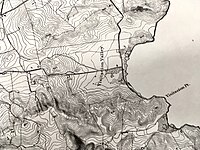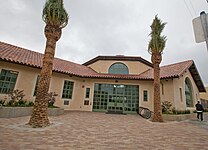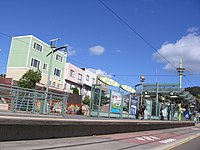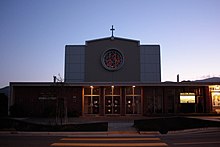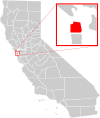Visitacion Valley, San Francisco
This article needs additional citations for verification. (October 2023) |
Visitacion Valley | |
|---|---|
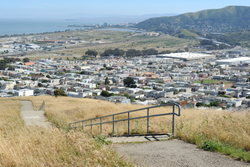 View southeast to Visitacion Valley and Brisbane from Visitacion Ave and Mansell Street in John McLaren Park. The stairs lead to Wilde Avenue. | |
| Nickname: Viz Valley | |
| Coordinates: 37°43′N 122°24′W / 37.717°N 122.400°W | |
| State | California |
| City | San Francisco |
| Government | |
| • Supervisor | Shamann Walton |
| • CA Assembly | Matt Haney (D)[1] |
| • State Senator | Scott Wiener (D)[1] |
| • U.S. Rep. | Kevin Mullin (D)[2] |
| Area | |
• Total | 1.582 sq mi (4.10 km2) |
| Population (2022) | |
• Total | 31,477 |
| • Density | 25,031/sq mi (9,665/km2) |
| Time zone | UTC-8 (PST) |
| • Summer (DST) | UTC-7 (PDT) |
| ZIP Code | 94134 |
| Area codes | 415/628 |
Visitacion Valley (VIZ-i-TAY-shən; Spanish: Valle de la Visitación),[3] colloquially referred to as Viz Valley,[4] is a neighborhood located in the southeastern quadrant of San Francisco, California.
Visitacion Valley is roughly defined by McLaren Park and Gleneagles Golf Course to the West, Mansell Blvd and Portola to the north, Bayview Hill and Candlestick Cove to the east, and the San Francisco / San Mateo County line to the south. The streets of this neighborhood straddle the border between San Francisco and Daly City, hence partially blending with the adjacent Daly City neighborhood of Bayshore. The grounds of the Cow Palace, straddling the San Francisco/Daly City border, parking areas are partially within Visitacion Valley.
The Sunnydale Housing Community, a predominately African-American and Pacific Islander American community, is located in Visitacion Valley.
Name
[edit]Visitacion Valley takes its name from Rancho Cañada de Guadalupe la Visitación y Rodeo Viejo, a large tract of land that also included the Bayshore district of Daly City, the city of Brisbane, and San Bruno Mountain.
The term "Visitacion" is Spanish[5] and a reference to the Visitation in Luke 1:39 of the Bible. It is a visit by Mary, bearing the child Jesus, to her cousin Elizabeth, who despite her advanced years is pregnant with John the Baptist. John leapt in the womb as Mary entered, knowing that he is in the presence of the Savior.
History
[edit]The area is a largely family-oriented working-class neighborhood. Average incomes and rents for the area are much lower than the citywide average. The area was originally settled by Irish, Spaniard American, Italian immigrants who worked in the nearby factories, as well as for Southern Pacific Railroad.[citation needed] The neighborhood once had the largest Maltese population outside of Malta.[6] The construction of the nearby Hunters Point Naval Shipyard during World War II, led to a massive influx of African Americans who worked in the shipyards. Many settled in the Sunnydale Projects which were originally constructed as barracks to house workers. After the war ended, more African Americans relocated from the Fillmore District and the Western Addition because the Urban Renewal program uprooted them and their businesses.[citation needed]

The former army barracks turned housing projects on Sunnydale Avenue, the Sunnydale Projects, is the largest in San Francisco[9][10] and remains one of the most violent areas of the city.[11][12] The two high-rise apartment buildings, Geneva Towers, originally built as private housing in the 1960s, were converted to public housing in the 1970s. They suffered through dilapidation and poor maintenance throughout the 1980s and were plagued by gangs and drug activity.[citation needed] The City ordered the destruction of the buildings in 1998[13] and replaced them with lower-density units.[14] Since the crackdown on crack cocaine in the mid-1990s and the demolition of the Geneva Towers public housing complex, crime in the neighborhood has been reduced, though many of the same problems remain.[citation needed] The Chinese American residency has grown and more businesses have opened on Leland Avenue.[citation needed]
Churches
[edit]The St. James Presbyterian Church was erected at 240 Leland Avenue in 1906. The current building was built in 1923 and designed by San Francisco Bay Area native architect Julia Morgan.[15][16]
In 1907, Archbishop Patrick William Riordan established a new parish in the Visitacion Valley. The original church was built on Cora Street, between Sunnydale and Visitacion avenues.[17] In 1909, the church was located at the corner of Loehr Street and Visitacion Avenue.[18] The third church was located between Raymond Avenue and Delta Street, using the material from the second church.[17] The current Church of the Visitacion is located at 655 Sunnydale Avenue, which has been there since at least 1961.[19] The Our Lady of the Visitacion School private Catholic K–8 school is located on the premises.[20][21] Its student population is close to 50% Filipino Americans.[22] Former California governor Peter Hardeman Burnett's house was also on the premises, on what was then called Burnet Grove. The house was later torn down to make way for the construction of the school.[17]
Media
[edit]The neighborhood was featured in the 1958 film The Lineup and the 2004 television film Sucker Free City.[citation needed]
In 1986, the Visitacion Valley Community Center began printing the free Visitacion Valley Grapevine community newspaper. In 2011, it ceased production, due to statewide budget cuts; it had a 25-year run.[23]
Events
[edit]In 2006, the annual Visitacion Valley Festival began, a street fair hosted along the commercial Leland Avenue and organized by the volunteer group Visitacion Valley Connections.[4]
Recent developments
[edit]The Visitacion Valley Redevelopment Area for the area centering at Leland Avenue and Bayshore Boulevard, including the former Schlage Lock Factory, was adopted by the Board of Supervisors in April 2009.[24] Home Depot proposed to build a big box store in March 2000. This proposal was dropped in January 2001 after opposition by neighborhood interests and local politicians.[25] The San Francisco Board of Supervisors approved interim rezoning to low-density commercial in January 2001. A transit-oriented mixed-use development (Visitacion Valley TOD Project) will be constructed on the former Schlage Lock Factory and Southern Pacific Rail Yard following demolition of existing buildings, except for the Historic Office Building, and brownfield remediation, which started after Remediation Action Plan was approved on November 16, 2009. This project will feature a grocery store, condos, parks, and other new redevelopment designed to revitalize the neighborhood.[26] Due to local redevelopment budgets all across California being cut by Governor Jerry Brown, development was delayed until 2014 and construction is currently expected to finish by 2021.[27][28]
Redevelopment also came in the construction of a new Muni Metro line called the T Third Street, which terminates at Sunnydale Station. The extension into the neighborhood was part of a major project to ultimately extend Muni to the northeast section of the city.
The old Visitacion Valley Branch of the San Francisco Public Library was leased out of a small storefront at 45 Leland Ave. The new, permanent branch is now closer to Visitacion Valley Elementary School. It opened on July 30, 2011 at 201 Leland Ave, at the site of the former Super Fair Market.[25][29]
Education
[edit]Elementary
[edit]- Visitacion Valley Elementary School
- El Dorado Elementary School
Middle school
[edit]- Visitacion Valley Middle School
- Our Lady of the Visitacion School (K–8)
Notable past residents
[edit]- Peter Hardeman Burnett, California governor (1849–1851)[17]
- Rikishi (Solofa F. Fatu Jr.), American professional wrestler[30]
- Dan White, San Francisco supervisor who assassinated Supervisor Harvey Milk and Mayor George Moscone in 1978[31]
Gallery
[edit]-
Elevation map of Visitacion Valley, 1869
-
Geneva Towers and Cow Palace, 1996
-
Exterior of new Visitacion Valley Branch library, 2011
-
Arleta Station along the T Third Street light rail line, 2012
-
Exterior of the Church of the Visitacion, February 2020
References
[edit]- ^ a b "Statewide Database". UC Regents. Retrieved November 9, 2014.
- ^ "California's 15th Congressional District - Representatives & District Map". Civic Impulse, LLC.
- ^ SF Católico - Bayview: Catequistas enfrentan nuevos retos con clases virtuales
- ^ a b John, King (2015-10-11). "Viz Valley fair celebrates a spot unmarred by gentrification". San Francisco Chronicle. Retrieved 2020-02-24.
- ^ Curiel, Jonathan (2008-06-02). "S.F.: Misspelled names in concrete corrected". SFGate. Retrieved 2020-02-25.
- ^ "S.F. no stranger to demographic shifts". The San Francisco Examiner. 2014-05-04. Retrieved 2020-03-08.
- ^ Johnson, Jason B. (1998-05-16). "Geneva Towers To Tumble / Troubled S.F. public housing project to be demolished today". SFGATE. Retrieved 2022-05-12.
- ^ "Why were the Geneva Towers demolished?". KALW. 2022-05-11. Retrieved 2022-05-12.
- ^ Hua, Vanessa (2005-03-11). "VISITACION VALLEY / Neighbors preserve lore and more / Longtimers' book project preserves the area's past". SFGate. Retrieved 2020-02-25.
- ^ Selna, Robert (2011-01-30). "Redevelopment key to Visitacion Valley revival". SFGate. Retrieved 2020-02-25.
- ^ "Homicides in San Francisco 2007-2009". Sfgate.com. Archived from the original on September 30, 2009. Retrieved 2009-10-30.
- ^ Fulbright, Leslie (February 3, 2008). "Life at the bottom: S.F.'s Sunnydale project". SF Gate.
- ^ Chip, Gibbons (1998). "Geneva Towers Implosion". Youtube. Archived from the original on 2021-12-22. Retrieved 2009-10-30.
- ^ "Geneva Towers to Tumble / Troubled S.F. Public housing project to be demolished today". 16 May 1998.
- ^ Visitacion Valley Grapevine (April 2004 ed.). Visitacion Valley Community Center. 2004.
- ^ Project, Visitacion Valley History (2005-12-07). San Francisco's Visitacion Valley. Arcadia Publishing. ISBN 978-1-4396-3096-9.
- ^ a b c d "HISTORY OF THE CHURCH OF THE VISITACION: 1907 to Present". www.visitacionchurch.org. Retrieved 2020-02-24.
- ^ Crocker-Langley San Francisco Directory. San Francisco, California: H.S. Crocker Company. 1909. p. 396.
- ^ "The Monitor 23 June 1961 — Catholic Research Resources Alliance". thecatholicnewsarchive.org. Retrieved 2020-02-24.
- ^ Ho, Vivian (2012-08-30). "Visitacion Valley sinkhole cleanup begins". SFGate. Retrieved 2020-02-24.
- ^ "Search for Private Schools - School Detail for OUR LADY OF THE VISITACION SCHOOL". nces.ed.gov. Retrieved 2020-02-24.
- ^ Carnes, Tony; Yang, Fenggang (2004). Asian American Religions: The Making and Remaking of Borders and Boundaries. NYU Press. p. 347. ISBN 978-0-8147-1630-4.
- ^ "What Happened to the Grapevine". Visitacion Valley Grapevine (January ed.). 2011.
- ^ "Redevelopment Agency : Home". SF Redevelopment Agency. Archived from the original on June 12, 2011. Retrieved 2009-10-30.
- ^ a b Hua, Vanessa (2005-04-09). "SAN FRANCISCO / A new vision for Vis Valley / Businesses' opening heralds hopes of economic revival". SFGate. Retrieved 2020-02-25.
- ^ "Visitacion Valley Redevelopment". renewvisvalley.com. Archived from the original on June 17, 2019. Retrieved 2009-10-30.
- ^ SF Planning. "Visitacion Valley/Schlage Lock Plan". sf-planning.org. Retrieved 2018-09-05.
- ^ Wildermuth, John (2014-04-28). "S.F. reaches deal for housing, retail at Schlage Lock site". SFGate. Retrieved 2020-02-25.
- ^ Bay City News (July 29, 2011). "Officials Expected To Gather To Celebrate Opening Of New Visitacion Valley Branch Library | SF Appeal: San Francisco's Online Newspaper". The San Francisco Appeal. Retrieved 2019-08-17.
- ^ Siggia, Chris (March 10, 2021). "Rikishi on being dead for three minutes after a drive-by shooting, how pro wrestling saved his life". Wrestling News. Retrieved March 26, 2021.
- ^ Eyerman, Ron (2019-04-09). Memory, Trauma, and Identity. Springer. ISBN 978-3-030-13507-2.




